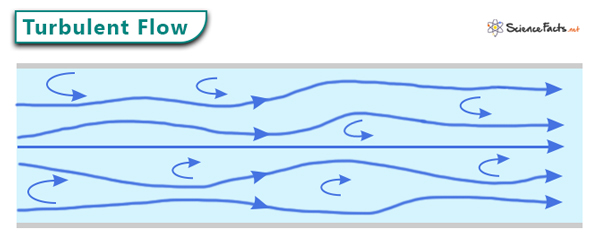Examples
Characteristics
Turbulent Flow and Reynolds Number
Turbulent Flow and Friction Factor
Applications
Swirling water currents in rivers Gusts of wind during stormsRise of cigarette smokeBlood flow in arteriesOil transport in pipelines
These natural phenomena demonstrate how turbulence affects our surroundings and influences various processes. Understanding turbulent flow is crucial in various fields, including engineering, physics, and even biology. Another essential characteristic is energy dissipation across various scales – from large-scale eddies to smaller dissipative structures. This energy dissipation contributes to the high levels of fluid layer mixing typically observed in a turbulent flow. Turbulent flow is known for its complex and unpredictable behavior, making it a challenging phenomenon to study and analyze accurately. Calculating the Reynolds number is the most common method to determine the flow regime. Reynolds number is a dimensionless parameter determining the transition between laminar and turbulent flow. Reynolds number is a numerical interpretation of the correlation between inertia and viscous forces, and mathematically, represented by the ratio between the two forces. Where ρ is the density of the fluid V is the velocity of the flow L is the characterizing length in the flow system (usually the diameter of the pipe) μ is the viscosity of the fluid This dimensionless number helps determine whether a fluid flow will be laminar or turbulent based on its velocity, density, viscosity, and characteristic length. Higher velocities and lower viscosities tend to promote turbulent flow. Also, larger pipe diameters can cause turbulence. The following conditions determine the flow regime in a pipe based on the Reynolds number:
When Re < 2300, flow is laminarWhen 2300 ≤ Re ≤ 4000, flow is transitionalWhen Re > 4000, flow is turbulent
In summary, when the viscous forces are pronounced, they are adequate to keep all the fluid particles in line, and the flow is laminar. When the inertial forces dominate over the viscous forces, the flow is turbulent. Laminar and turbulent flows can exist in the same conduit when operated at different flow rates. Also, suppose the flow has a different geometry, such as flow in a square duct or over a turbine blade. In that case, the transition will occur at different values of the Reynolds number. Darcy–Weisbach equation gives a relationship between the pressure loss or head loss due to friction along the given length of pipe to the average velocity of the fluid flow for an incompressible fluid. This equation contains a dimensionless friction factor, known as the Darcy friction factor, which can be determined using empirical equations derived from extensive experimental data.
